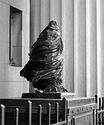Dali
Member
Yes, it starts to be boring...
Yesterday, after 18 months without lab, I finally develop some papers. And, bad luck, all of them got a bloody yellow stain near the edge, far enough not only to stain the margin but also the prints.
I used my regular developemnt process (2.5 minutes Dektol + slight rince with very waek fixer bath + 2 minutes Ilford fixer) and noticed the trouble as I started to wash the prints.
I bought the paper I used (Ilford MG FB) 20 months ago and stored it in a cool place.
So, is the paper too old or can it comes from something else?
NOTA: I had by the past a similar trouble with Oriental FB paper.
Yesterday, after 18 months without lab, I finally develop some papers. And, bad luck, all of them got a bloody yellow stain near the edge, far enough not only to stain the margin but also the prints.
I used my regular developemnt process (2.5 minutes Dektol + slight rince with very waek fixer bath + 2 minutes Ilford fixer) and noticed the trouble as I started to wash the prints.
I bought the paper I used (Ilford MG FB) 20 months ago and stored it in a cool place.
So, is the paper too old or can it comes from something else?
NOTA: I had by the past a similar trouble with Oriental FB paper.







